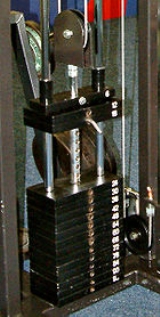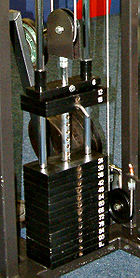
Weight machine
Encyclopedia
A weight machine is an exercise machine
used for weight training
that uses gravity as the primary source of resistance and a combination of simple machine
s to convey that resistance to the person using the machine. Each of the simple machines (pulley, lever, wheel, incline) changes the mechanical advantage
of the overall machine relative to the weight.
 A stack machine—also called a stack or rack—has a set of massive rectangular plates that are pierced by a vertical bar which has holes drilled in it to accept a pin. Each of the plates has a channel on its underside (or a hole through the middle, as shown in the diagram) that aligns with one of the holes. When the pin is inserted through the channel into the hole, all of the plates above the pin rest upon it, and are lifted when the bar rises. The plates below do not rise. This allows the same machine to provide several levels of resistance over the same range of motion with an adjustment that requires very little force to accomplish in itself.
A stack machine—also called a stack or rack—has a set of massive rectangular plates that are pierced by a vertical bar which has holes drilled in it to accept a pin. Each of the plates has a channel on its underside (or a hole through the middle, as shown in the diagram) that aligns with one of the holes. When the pin is inserted through the channel into the hole, all of the plates above the pin rest upon it, and are lifted when the bar rises. The plates below do not rise. This allows the same machine to provide several levels of resistance over the same range of motion with an adjustment that requires very little force to accomplish in itself.
The means of lifting the bar varies. Some machines have a roller at the top of the bar that sits on a lever. When the lever is raised the bar can go up and the roller moves along the lever, allowing the bar to stay vertical. On some machines the bar is attached to a hinge on the lever, which causes swaying in the bar and the plates as the lever goes up and down. On other machines the bar is attached to a cable or belt, which runs through pulleys or over a wheel. The other end of the cable will either be a handle or strap that the user holds or wraps around some body part, or will be attached to a lever, adding further simple machines to the mechanical chain.
Usually, each plate is marked with a number. On some machines these numbers give the actual weight of the plate and those above it. On some, the number gives the force at the user's actuation point with the machine. And on some machines the number is simply an index counting the number of plates being lifted.
The early Nautilus
machines were a combination of lever and cable machines. They also had optional, fixed elements such as a chinning bar.
) use standard barbell plates instead of captive stacks of plates. They combine a bar-end on which to hang the plates with a number of simple machines to convey the force to the user.
The plate-loaded machines will often have a very high mechanical advantage, due to the need to make room for large plates over a large range of motion
following a path that causes them to converge at one end or the other. Also, the motion will generally not be vertical, and the net resistance is equal to the cosine of the angle at which it is moving relative to vertical.
For example, consider an incline press machine that is a single-lever machine that has the plates halfway up the lever from the handles to the fulcrum
, and begins moving the plates at a 45-degree
angle from vertical. The lever will provide a leverage advantage of 2:1, and the incline will have an advantage of 1:√2/2, for a net mechanical advantage of . Thus of plates will apply to the user only an equaling weight of or a force of at the beginning of the motion.
On the other end of the spectrum may be a bent-over-row machine that is designed with the user's grip between the plates and the fulcrum. This amplifies the force needed by the user relative to the weight of the plates.
Exercise machine
An exercise machine is any machine used for physical exercise. These range from simple spring-like devices to computerized electromechanical rides to recirculating-stream swimming pools...
used for weight training
Weight training
Weight training is a common type of strength training for developing the strength and size of skeletal muscles. It uses the weight force of gravity to oppose the force generated by muscle through concentric or eccentric contraction...
that uses gravity as the primary source of resistance and a combination of simple machine
Simple machine
A simple machine is a mechanical device that changes the direction or magnitude of a force.In general, they can be defined as the simplest mechanisms that use mechanical advantage to multiply force. A simple machine uses a single applied force to do work against a single load force...
s to convey that resistance to the person using the machine. Each of the simple machines (pulley, lever, wheel, incline) changes the mechanical advantage
Mechanical advantage
Mechanical advantage is a measure of the force amplification achieved by using a tool, mechanical device or machine system. Ideally, the device preserves the input power and simply trades off forces against movement to obtain a desired amplification in the output force...
of the overall machine relative to the weight.
Stack machines

The means of lifting the bar varies. Some machines have a roller at the top of the bar that sits on a lever. When the lever is raised the bar can go up and the roller moves along the lever, allowing the bar to stay vertical. On some machines the bar is attached to a hinge on the lever, which causes swaying in the bar and the plates as the lever goes up and down. On other machines the bar is attached to a cable or belt, which runs through pulleys or over a wheel. The other end of the cable will either be a handle or strap that the user holds or wraps around some body part, or will be attached to a lever, adding further simple machines to the mechanical chain.
Usually, each plate is marked with a number. On some machines these numbers give the actual weight of the plate and those above it. On some, the number gives the force at the user's actuation point with the machine. And on some machines the number is simply an index counting the number of plates being lifted.
The early Nautilus
Arthur Jones (inventor)
Arthur Allen Jones was the founder of Nautilus, Inc. and MedX, Inc. and the inventor of the Nautilus exercise machines, including the Nautilus pullover, which was first sold in 1970...
machines were a combination of lever and cable machines. They also had optional, fixed elements such as a chinning bar.
Plate-loaded machines
Plate-loaded machines (such as the Smith machineSmith machine
The Smith machine is a piece of equipment used in weight training. It consists of a barbell that is fixed within steel rails, allowing only vertical movement. New variations allow a small amount of forward and backward movement. A Smith machine often includes a weight rack in the base to help...
) use standard barbell plates instead of captive stacks of plates. They combine a bar-end on which to hang the plates with a number of simple machines to convey the force to the user.
The plate-loaded machines will often have a very high mechanical advantage, due to the need to make room for large plates over a large range of motion
Range of motion
Range of motion , is the distance that a movable object may normally travel while properly attached to another object. It is also called range of travel, particularly when talking about mechanical devices and in mechanical engineering fields...
following a path that causes them to converge at one end or the other. Also, the motion will generally not be vertical, and the net resistance is equal to the cosine of the angle at which it is moving relative to vertical.
For example, consider an incline press machine that is a single-lever machine that has the plates halfway up the lever from the handles to the fulcrum
Lever
In physics, a lever is a rigid object that is used with an appropriate fulcrum or pivot point to either multiply the mechanical force that can be applied to another object or resistance force , or multiply the distance and speed at which the opposite end of the rigid object travels.This leverage...
, and begins moving the plates at a 45-degree
Degree (angle)
A degree , usually denoted by ° , is a measurement of plane angle, representing 1⁄360 of a full rotation; one degree is equivalent to π/180 radians...
angle from vertical. The lever will provide a leverage advantage of 2:1, and the incline will have an advantage of 1:√2/2, for a net mechanical advantage of . Thus of plates will apply to the user only an equaling weight of or a force of at the beginning of the motion.
On the other end of the spectrum may be a bent-over-row machine that is designed with the user's grip between the plates and the fulcrum. This amplifies the force needed by the user relative to the weight of the plates.
See also
- Cable machineCable machineA cable machine is an item of equipment used in weight training or functional training. It consists of a rectangular, vertically-oriented steel frame about 3 metres wide and 2 metres high, with a weight stack at each end. The cables that connect the handles to the weight stacks run through...
- Smith machineSmith machineThe Smith machine is a piece of equipment used in weight training. It consists of a barbell that is fixed within steel rails, allowing only vertical movement. New variations allow a small amount of forward and backward movement. A Smith machine often includes a weight rack in the base to help...
- Leg pressLeg pressThe leg press is a weight training exercise in which the individual pushes a weight or resistance away from them using their legs. The term leg press also refers to the apparatus used to perform this exercise...
- Exercise
- KinesiologyKinesiologyKinesiology, also known as human kinetics is the scientific study of human movement. Kinesiology addresses physiological, mechanical, and psychological mechanisms. Applications of kinesiology to human health include: biomechanics and orthopedics, rehabilitation, such as physical and occupational...
- Personal trainerPersonal trainerA personal trainer is a fitness professional involved in exercise prescription and instruction. They motivate clients by setting goals and providing feedback and accountability to clients. Trainers also measure their client's strengths and weaknesses with fitness assessments...
- Exercise physiologyExercise physiologyExercise physiology is the study of the acute responses and chronic adaptations to a wide-range of physical exercise conditions. In addition, many exercise physiologists study the effect of exercise on pathology, and the mechanisms by which exercise can reduce or reverse disease progression...
- HealthHealthHealth is the level of functional or metabolic efficiency of a living being. In humans, it is the general condition of a person's mind, body and spirit, usually meaning to be free from illness, injury or pain...

